A hot bath outdoors can be the ultimate relaxation after a long day.
But how do you heat your hot tub to the perfect temperature?
This question concerns many wellness lovers who want to enjoy the luxury of their own hot tub.
In my detailed blog article on wellnessfuerdraussen.de you will learn everything you need to know about how to heat your hot tub - whether with a wood stove, an electric stove or by connecting it to your home heating system.
Immerse yourself in the world of outdoor wellness and be inspired by my tips on how to turn your hot tub into your personal wellness paradise.
At a glance:
Overview of the possible heating sources
Heating a hot tub with an electric heater
Heating a hot tub with a hybrid stove
Heating a hot tub with a gas heater
Heating a hot tub with a heat exchanger
Heating a hot tub with a wood stove
Conclusion
Note: Are you from Ortenau and the surrounding area? Visit us so you can buy your hot tub nearby !
Overview of the possible heating sources
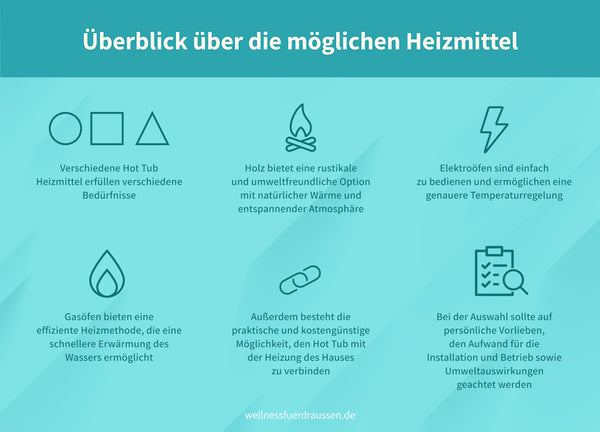
Before purchasing a hot tub and choosing a heating medium for your hot tub, it is important to carefully consider the different options to ensure you make the right choice for your needs.
The most commonly used heating medium is wood, which is a rustic and eco-friendly option. Using a wood stove allows you to enjoy the natural warmth of the fire and create a relaxing atmosphere.
Electric ovens are another popular option because they are easy to use and allow for more precise temperature control. You can also add an electric oven to a wood-burning stove, creating what is known as a hybrid heater.
Gas stoves offer an efficient heating method that allows water to heat up faster.
Finally, there is the possibility of connecting the hot tub to the house's existing heating system, which can be a practical and cost-effective solution.
Consider your personal preferences, the effort required for installation and operation, and the environmental impact to choose the best heating method for your hot tub.
Reading tip: Pure relaxation: Why a hot tub is the perfect place for wellness
Heating a hot tub with an electric heater
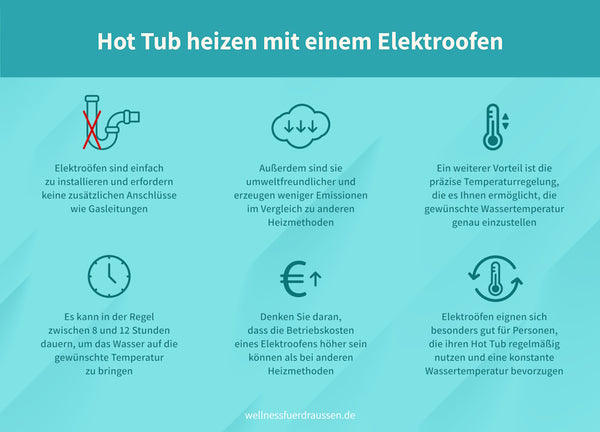
If you heat your hot tub with an electric heater , you will benefit from a number of advantages.
Electric stoves are easy to install and do not require additional connections such as gas pipes. They are also more environmentally friendly and produce fewer emissions compared to other heating methods.
Another advantage is the precise temperature control, which allows you to set the desired water temperature exactly. For this, the hot tub should be equipped with a thermostat.
The time it takes to heat your hot tub with an electric heater will depend on the size of the tub and the power of the heater, but typically it can take between 8 and 12 hours to get the water to the desired temperature.
You can usually choose between electric ovens with 3.0kW and 6.0kW power. Experience shows that the water heats up at 2°C per hour.
Make sure the electric oven has adequate safety precautions to prevent overheating.
Keep in mind that the running costs of an electric furnace may be higher than other heating methods, but they also allow for easier heating of the water.
Electric heaters are particularly suitable for people who use their hot tub regularly and prefer a constant water temperature.
Reading tip: Integrating a hot tub in the garden: How to do it right
Heating a hot tub with a hybrid stove
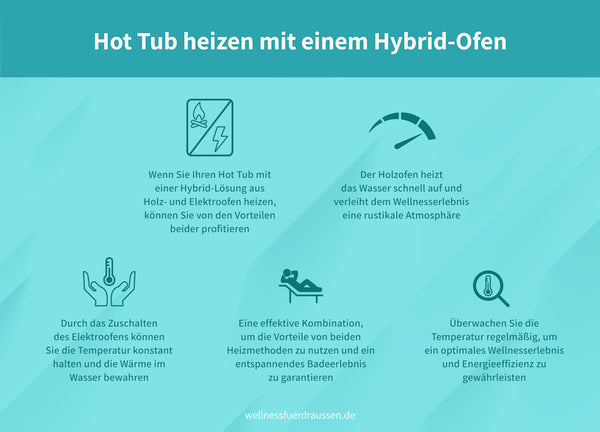
If you want to heat your hot tub with a hybrid solution of a wood stove and an electric stove, you can benefit from the advantages of both solutions.
The wood-burning stove heats the water quickly and gives the wellness experience a rustic atmosphere. By switching on the electric stove, you can keep the temperature constant and retain the warmth in the water.
An effective combination to utilize the benefits of both heating methods and guarantee a relaxing bathing experience.
Make sure you monitor the temperature regularly to ensure an optimal wellness experience and maximize energy efficiency.
Reading tip: You should know these 5 hot tub regulations
Heating a hot tub with a gas heater
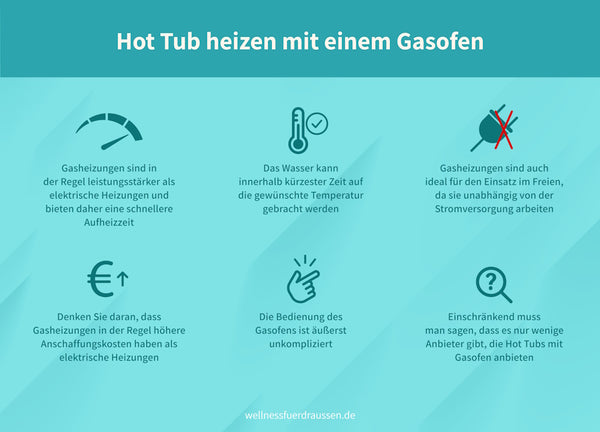
Heating your hot tub with a gas heater allows you to reach your desired water temperature quickly and efficiently. Gas heaters are usually more powerful than electric heaters and therefore offer a faster heat-up time.
The gas heater is connected directly to the hot tub and provides a constant source of heat. This is particularly practical if you want to spend a spontaneous, relaxing evening in the hot tub, as the water can be heated to the desired temperature in no time.
The gas ovens usually have an output of 36kW and are designed for liquid gas (propane gas).
Gas heaters are also ideal for outdoor use as they operate independently of the power supply and can therefore also be used in remote areas.
Remember that gas heaters usually have a higher initial cost than electric heaters, but they are characterized by their efficiency and speed.
The gas heater is extremely easy to operate. Connect the hose from the gas heater to your liquid gas/LPG source and heating can begin. Depending on the initial temperature of the water, around 4-5 kg of LPG is required to reach 38 degrees Celsius.
It must be said that there are only a few suppliers who offer hot tubs with gas heaters.
Reading tip: Hot tub care in 4 easy steps
Heating a hot tub with a heat exchanger
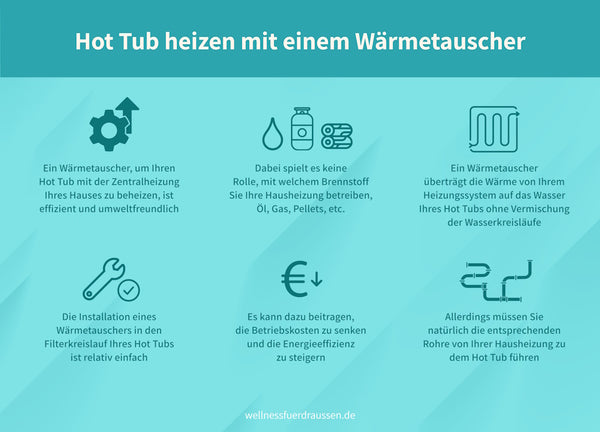
Using a heat exchanger to heat your hot tub with your home's central heating is an efficient and environmentally friendly way to keep your spa warm.
It does not matter which fuel you use to heat your home, oil, gas, pellets, etc.
A heat exchanger allows the heat from your heating system to be transferred to your hot tub water without the two water circuits mixing. This process ensures that your hot tub is heated to comfortable temperatures without compromising the comfort of your home.
Installing a heat exchanger into your hot tub's filtration circuit is relatively simple and can help reduce operating costs and increase energy efficiency.
However, you will of course need to run the appropriate pipes from your home heating system to the hot tub.
By using the heat from your central heating to heat your hot tub, you can not only save money but also help the environment.
Reading tip: The 10 most important hot tub manufacturers from Europe
Heating a hot tub with a wood stove

Heating the hot tub with a wood stove is the classic, the original so to speak. And heating the hot tub with wood is still the most popular option.
There are several reasons for this.
Many of us have wood at home to heat the tiled stove or for similar applications. Then you can use these prepared logs to heat the hot tub with wood stove .
In addition, you do not need an electrical connection for a wood-burning stove, so you can set up the hot tub even where there is no electricity.
Since wood is a renewable raw material, heating with wood is also one of the sustainable energy sources.
The emotional aspect is also important. The wood stove symbolizes primitiveness and coziness. The smoke from the chimney and the crackling of the wood in the stove quickly create an atmosphere of relaxation and letting go.
Product tip: Holzklusiv Hot Tub Saphir Spa Deluxe
A few more words about the technology:
When heating your hot tub with a wood stove, it is important to use the correct technique to efficiently generate heat and get the water to the desired temperature.
Start by putting dry wood in the stove, as wet wood not only burns slower but also produces more smoke and debris.
It is best to start with wood from softer tree species such as spruce or pine, which burn faster. Then you can move on to beech and oak, so-called hardwoods, which retain their temperature for longer.
Be sure to stoke the fire regularly, every 15 – 20 minutes, to ensure a continuous heat source.
Use logs that are 25 to 30 cm long for faster and even combustion. These are the same logs that are used in many basic stoves (tiled stoves).
There are several factors that determine how exactly heating the hot tub with the wood stove works, what quantities are needed, etc.
Such factors are:
- The size of the hot tub
- The difference between air temperature and water temperature
- The position of the wood stove: inside or outside
If you want to regulate the temperature of the water in the hot tub, you can adjust the amount of wood in the stove.
Experiment with different types of wood to find the one that gives you the heat and flame you desire.
Remember, safety always comes first - place the wood burning hot tub in a safe location, away from flammable materials, and always monitor the fire closely.
With these tips, you can optimally heat your hot tub with a wood stove and enjoy a relaxing bathing experience outdoors.
Conclusion
In conclusion, efficient and safe heating of your hot tub is an important aspect for an untroubled wellness experience.
With the right tips and tricks, you can not only save energy, but also control the duration and temperature of your bath according to your wishes.
If you want to delve deeper into the topic, I recommend that you subscribe to our newsletter. There you will find further information and detailed instructions on how to heat and use your hot tub optimally.
May every stay in your bubbling paradise be an unforgettable pleasure!
